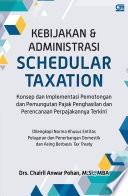
Kebijakan Dan Administrasi Schedular Taxation; Konsep Dan Implementasi Pemotongan Dan Pemungutan Pajak Penghasilan Dan Perencanaan Perpajakannya Terkini
Kontribusi pajak semakin signifi kan dan diperhitungkan sebagai tulang punggung sumber pembiayaan nasional untuk menyukseskan program-program pembangunan, yang secara bertahap akan meningkatkan pertumbuhan ekonomi serta kesejahteraan masyarakat. Pertumbuhan jumlah wajib pajak mengindikasikan bahwa kesadaran dan kepatuhan masyarakat untuk melaksanakan hak dan kewajiban perpajakannya secara baik dan benar semakin meningkat. Meski demikian, masih banyak kendala yang dihadapi oleh fiskus di lapangan dalam memasyarakatkan pelaksanaan pajak pusat. Dengan bahasa yang jelas dan lugas buku ini membahas siapa saja subjek pajak, apa saja objek pajak, cara menghitung pajak, tata cara memotong serta memungut pajak, dan cara menyetorkan serta melaporkannya. Secara mendetail, buku yang ditulis berdasarkan penelitian dan pengalaman penulis sebagai praktisi, konsultan, dan dosen perpajakan ini memaparkan teori, konsep, aplikasi kebijakan, dan administrasi pemotongan serta pemungutan pajak penghasilan di Indonesia, yang meliputi PPh Pasal 21, Pasal 22, Pasal 23, Pasal 24, Pasal 26, Pasal 4 Ayat 2 (Final), dan Pasal 15. Selain itu, di sini pembaca juga bisa mempelajari tax planning terkini, yang disertai dengan banyak contoh perhitungan dalam berbagai variasi. Dengan pembahasan yang sedemikian lengkap, buku ini tidak hanya bermanfaat bagi orang pribadi, dunia usaha, dan para pemangku kepentingan perpajakan untuk memperoleh pengetahuan yang komprehensif dan aktual, tetapi juga dapat digunakan sebagai buku ajar mata kuliah Pajak Penghasilan: Pemotongan dan Pemungutan di perguruan tinggi baik untuk tingkat Strata I maupun Program Diploma (D-I s/d D-IV), jurusan administrasi bisnis, akuntansi, perpajakan, manajemen, dan sebagai materi pelatihan perpajakan, termasuk Brevet A/B.
- ISBN 13 : 6020660842
- ISBN 10 : 9786020660844
- Judul : Kebijakan Dan Administrasi Schedular Taxation; Konsep Dan Implementasi Pemotongan Dan Pemungutan Pajak Penghasilan Dan Perencanaan Perpajakannya Terkini
- Pengarang : Drs. Chairil Anwar Pohan, M.Si., MBA,
- Kategori : Law
- Penerbit : Gramedia Pustaka Utama
- Bahasa : id
- Tahun : 2022
- Halaman : 548
- Google Book : https://play.google.com/store/books/details?id=lGZkEAAAQBAJ&source=gbs_api
-
Ketersediaan :
... investasi;dan hasil kas dan usaha b lis deposito,h in g / K (laporan G - 3 / G C tabungan, laba rugi); Sertifikat Bank 3. Indonesia, dan Dalam hal permohonan Sertifikat tersebut a lPBank u ditandatangani bank; Indonesia Syariah.









